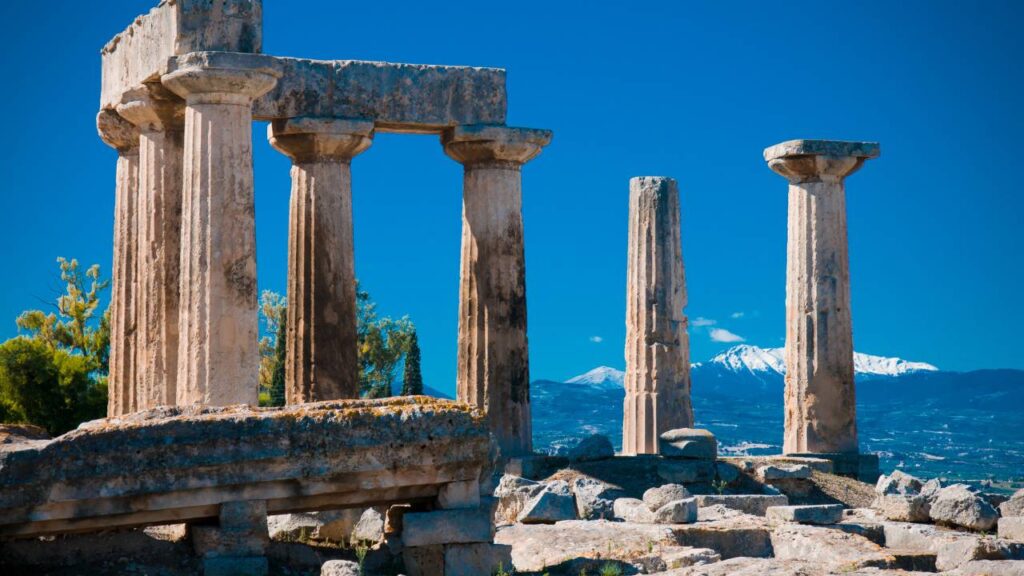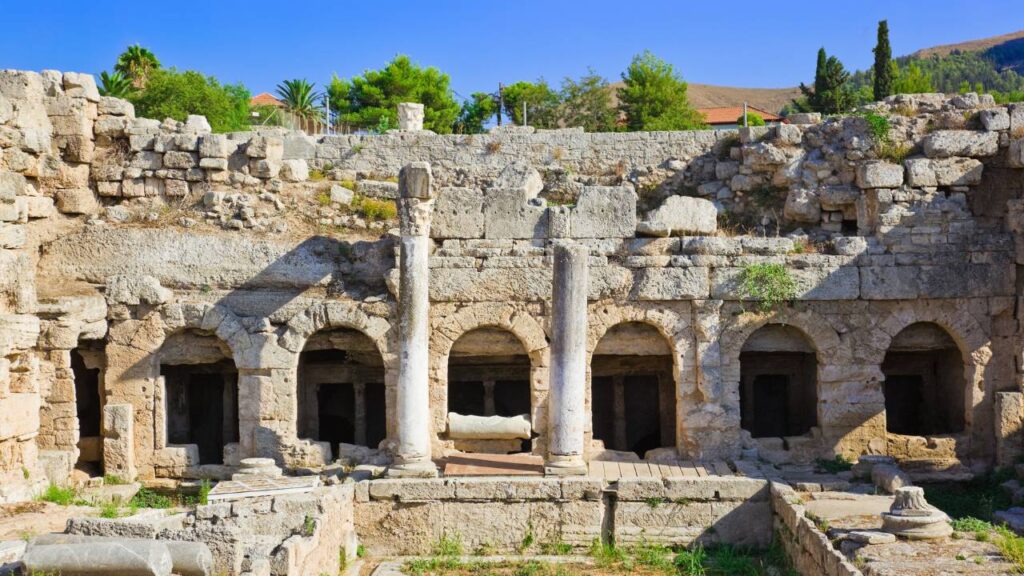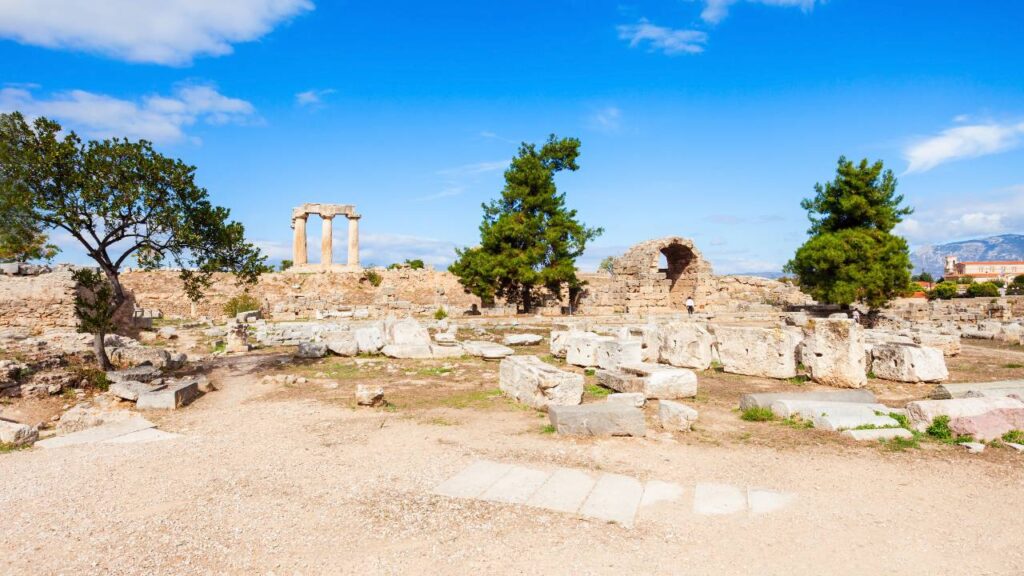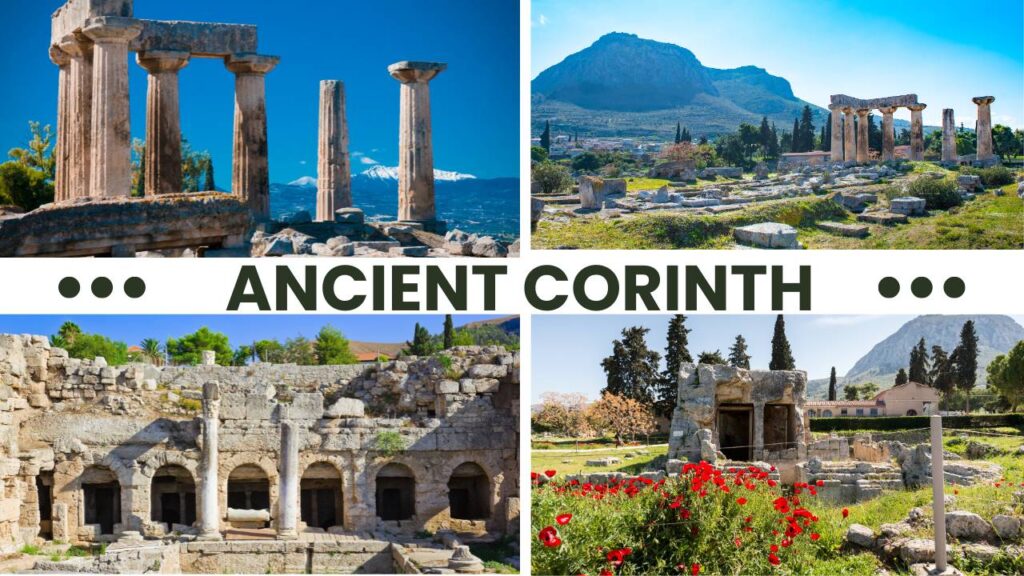Pick rich history and top attractions of Ancient Corinth, along with essential travel tips on how to reach this iconic destination.
Ancient Corinth is one of Greece’s most fascinating historical destinations, rich in cultural significance, biblical references, and awe-inspiring ruins. Once a thriving city-state and a powerful trading hub in the ancient world, Corinth played a pivotal role in Greek and Roman civilization. For travelers seeking a blend of mythology, history, and breathtaking archaeological wonders, Ancient Corinth offers an unforgettable journey through time. This comprehensive travel guide takes you deep into the glorious past of Ancient Corinth, visit its top attractions, and provides practical tips on how and when to visit.
Glorious Past: Rich History of Ancient Corinth
Ancient Corinth’s history dates back to the Neolithic period, but the city truly flourished from the 8th century BCE. Positioned strategically between mainland Greece and the Peloponnesian peninsula, Corinth became a key player in both trade and military matters. Its wealth and influence grew rapidly due to its access to two important ports: Lechaeum on the Corinthian Gulf and Cenchreae on the Saronic Gulf.

By the 7th century BCE, Corinth emerged as a center of innovation in art, architecture, and commerce. The city is credited with developing the Corinthian order, one of the classical styles of ancient Greek architecture, known for its ornate columns and elaborate capitals. During the classical period, Corinth rivaled Athens and Sparta in military power and cultural influence.
In 146 BCE, the Romans destroyed the city, but Julius Caesar rebuilt it a century later. Under Roman rule, Corinth became the provincial capital of Achaea and regained much of its former glory. The city not only thrived in wealth but also boasted religious diversity, with temples dedicated to Apollo, Aphrodite, and other gods. It became a significant center for Christianity when the Apostle Paul visited and established a strong Christian community, making Corinth an important location in the New Testament.
Corinth Archaeological Site: Walk Through Ancient Ruins
The Corinth Archaeological Site offers a stunning glimpse into the city’s rich past, with well-preserved ruins from both Greek and Roman periods. The Temple of Apollo, dating back to the 6th century BCE, stands as the site’s most iconic structure, showcasing impressive Doric columns. Nearby, the Agora, the ancient marketplace, and the Bema, where St. Paul is believed to have spoken, offer fascinating insights into Corinth’s religious and commercial life.
Other key features include the Fountain of Peirene, a legendary water source linked to Greek mythology, and the Roman Odeon, a venue for performances and gatherings. The Corinth Archaeological Museum, located nearby, houses an extensive collection of artifacts such as statues, mosaics, and everyday items used by the ancient Corinthians.
The site masterfully blends Greek, Roman, and Christian heritage, providing visitors with a multi-layered experience of Corinth’s cultural significance.
How to Reach Ancient Corinth: Travel Options from Athens and Beyond
Reaching Ancient Corinth is straightforward, making it a popular day trip from Athens. The site is located approximately 80 kilometers (about 50 miles) west of the capital, with several convenient travel options available:
By Car:
Driving offers the most flexibility and convenience. The journey takes about 1 to 1.5 hours via the Olympia Odos (A8) highway. Rental cars are widely available in Athens, and the route is clearly marked with signs directing you to Corinth. Once on the highway, the drive is scenic and easy, making it a great option for those who prefer traveling at their own pace.
By Train:
You can take the suburban railway (Proastiakos) from Athens to Korinthos Station, located in modern Corinth, about 7 kilometers from the archaeological site. From there, taxis or local buses are available to take you to the ancient ruins. The train journey offers comfortable and scenic views of the Greek countryside, and it takes about 1 hour to reach Corinth.
By Bus:
KTEL buses run regularly from the Athens Kifissos Bus Terminal to Corinth, with the ride taking about 90 minutes. Once in Corinth, you’ll need a local taxi or bus to reach the archaeological site. The buses are affordable and a good option if you’re looking for a budget-friendly trip.
By Guided Tour:
Many travel agencies offer full or half-day guided tours from Athens to Ancient Corinth, often including visits to the Corinth Canal or nearby Mycenae. These tours are a fantastic way to gain deeper insight into the history of the area, as they often include knowledgeable guides who provide rich historical context throughout the journey.
By Private Transfer:
For a more personalized and comfortable experience, private transfers are also available. Whether you’re traveling solo, with a partner, or in a group, this option offers door-to-door service and a more relaxed pace. Many companies also offer custom tours to cater to specific interests, such as archaeological exploration or Greek mythology.
When to Visit Ancient Corinth: Best Seasons, Weather, and Local Tips
Timing your visit can significantly enhance your experience at Ancient Corinth, as the region’s Mediterranean climate offers varying conditions throughout the year.

Spring (March to May):
Spring is arguably the best time to visit Ancient Corinth. The weather is mild, with temperatures averaging between 15°C (59°F) and 25°C (77°F), making it perfect for exploring the ruins comfortably. The landscape is lush and green, and the surrounding hills are blanketed with blooming wildflowers. The pleasant temperatures and fewer tourists create an ideal environment for leisurely exploration.
Spring offers fantastic photography opportunities, with clear skies and vibrant landscapes providing a beautiful backdrop for the ancient ruins. You’ll also enjoy the tranquility of a quieter site, allowing for more personal reflection and immersive experiences.
Summer (June to August):
Summer at Ancient Corinth brings long, sunny days and higher temperatures, often exceeding 35°C (95°F). While the heat can be overwhelming, the extended daylight hours offer plenty of time to visit. If you’re visiting during this period, it’s best to arrive early in the morning to avoid the midday heat. Wear light clothing, a wide-brimmed hat, and bring plenty of water, sunscreen, and snacks to stay comfortable.
The summer months also tend to attract more tourists, especially during peak travel season, so be prepared for larger crowds at popular spots. Despite the heat, the summer months do offer the chance to witness the site under the brilliant sunlight, enhancing the dramatic effect of the ruins against the clear sky.
Autumn (September to November):
Autumn is another excellent time to visit, particularly September and October when temperatures are more moderate, ranging between 20°C (68°F) and 30°C (86°F). The heat of the summer subsides, making it more comfortable to the archaeological site and surrounding area. The post-summer lull also means fewer tourists, allowing for a more peaceful experience.
Fall months provide beautiful seasonal changes, with the landscape turning golden and the weather still mild enough for outdoor activities. The local harvest season can add an extra layer of charm, with fresh produce and seasonal festivals contributing to the overall experience.
Winter (December to February):
Winter is the least crowded season at Ancient Corinth, offering a quiet and reflective atmosphere. While the weather can be cooler, with temperatures ranging from 5°C (41°F) to 15°C (59°F), it rarely drops to freezing, though occasional rain showers are common. This is the ideal time for those seeking solitude, as the absence of tourists allows for a more personal experience with the ruins.
Cooler weather means you’ll need to dress warmly, and some parts of the site may be slippery after rainfall. Be sure to check for any seasonal closures of the site or museum, as some areas may operate on reduced hours during the winter months. Despite the chill, winter offers a peaceful, contemplative way to visit Corinth’s ancient history.
Local Festivals and Events:
For a unique and enriching experience, try to align your visit with local festivals or religious celebrations. These events, often held during the spring and autumn, feature traditional food, music, and cultural performances that highlight the rich heritage of Corinth. You might catch festivals like the Corinthian Festival or regional celebrations tied to ancient traditions. Participating in these events can give you a deeper connection to the culture and history of the area, making your visit even more memorable.
Top Attractions in Ancient Corinth You Can’t Miss
Ruins of Ancient Corinth offer a stunning and immersive journey into the past, with each landmark telling a unique story of the city’s rich and diverse history. From its ancient Greek origins to Roman influence and early Christian connections, these sites encapsulate the cultural and historical significance that made Corinth a central hub in the ancient world.

Here are some of the top attractions in Ancient Corinth you can’t miss:
- Temple of Apollo
- Acrocorinth (Upper Corinth)
- Peirene Fountain
- Lechaion Road and Roman Forum
- Odeon and Theatre
- Bema of St. Paul
Temple of Apollo: Glimpse into Ancient Religious Architecture
The Temple of Apollo stands as one of the most iconic structures in Ancient Corinth and is among the oldest stone temples in Greece. Built in the 6th century BCE, the temple once housed a massive statue of Apollo, which was a major religious site for the people of Corinth. Today, its six imposing Doric columns remain standing, offering a glimpse of the grandeur that once was.
These columns, though weathered, still exude a sense of the city’s power and cultural importance during its height. The temple’s location on the edge of the ancient city provides visitors with not only a connection to Corinth’s religious past but also a chance to reflect on the engineering feats of ancient Greek architecture.
Acrocorinth (Upper Corinth): Fortress Overlooking the City
The Acrocorinth is the towering acropolis that overlooks the ancient city of Corinth from a height of 575 meters (1,887 feet), offering panoramic views of the surrounding landscape, including the Corinthian Gulf and the Peloponnesian peninsula. The fortress is a remarkable site, with its ancient fortifications still visible and well-preserved.
The acropolis served as a stronghold for the Corinthians for centuries, with the city’s defensive walls, gates, and watchtowers strategically placed to protect the city from invaders. It also houses the remains of several temples, including a sanctuary dedicated to Aphrodite, and ancient cisterns that once provided water to the city’s population. A visit to Acrocorinth allows you to walk through ancient fortifications and experience the breathtaking views that once made this location so crucial for the defense of Corinth.
Peirene Fountain: Legendary Water Source
The Peirene Fountain is one of the most famous and legendary natural springs in Greek mythology, deeply entwined with the stories of gods and heroes. The fountain was a vital water source for the ancient city of Corinth, providing fresh water to its citizens. According to myth, the fountain was created by the tears of the nymph Peirene, and it was said that her waters possessed magical qualities. Over the centuries, the fountain became an important cultural and religious symbol, with a temple dedicated to the nymphs located nearby.
Today, the fountain remains a key feature of the archaeological site, with its flowing waters and the surrounding ruins providing a peaceful and reflective spot for visitors. The site’s history, along with its connection to Greek mythology, makes it a must-see for anyone interested in both the practical and mythical aspects of ancient Corinthian life.
Lechaion Road and Roman Forum: Walking the Path of Ancient Corinthians
One of the most engaging aspects of visiting Ancient Corinth is the opportunity to walk along the Lechaion Road, which once connected the city center to the bustling port of Lechaeum on the Corinthian Gulf. This wide, paved road was a vital commercial route that allowed goods, people, and ideas to flow in and out of Corinth, cementing its role as a trade powerhouse in the ancient world.
The Roman Forum, located near the city center, offers further insight into the city’s civic and administrative life during the Roman period. This large open space was the hub for public life in Corinth, where markets, political meetings, and cultural events took place. Walking these paths gives visitors a sense of connection to the daily lives of ancient Corinthians, as they navigate the same streets and experience the same landmarks that were once so central to the city’s operation.
Odeon and Theatre: Ancient Entertainment Venues
The Odeon and Theatre are two important Roman-era structures that once hosted cultural and entertainment events, bringing art and performance to the citizens of Ancient Corinth. The Odeon, a small roofed theatre, was primarily used for musical performances, while the larger Theatre hosted plays, public speeches, and other large-scale events. Both venues provide valuable insights into the social and cultural life of Corinth during its Roman era.
The theatre, with its partially preserved seating arrangements, still exudes a sense of grandeur, with views that extend to the surrounding ruins and the scenic landscape beyond. These structures are a reminder of Corinth’s importance as a center of cultural exchange, where the arts flourished alongside commerce and military prowess.
Bema of St. Paul: Place of Biblical Significance
The Bema of St. Paul is one of the most historically and biblically significant sites in Ancient Corinth. It is here that the Apostle Paul is believed to have delivered his famous speech before Gallio, the Roman proconsul, as recorded in the New Testament. This event marked a pivotal moment in the spread of Christianity, as Gallio’s decision not to prosecute Paul helped to establish Christianity as a distinct religion within the Roman Empire.
The Bema, a raised platform, is located in the heart of the ancient city and serves as a reminder of the important religious transformations that took place in Corinth. Visitors can stand in the very spot where one of the foundational moments of early Christian history unfolded, adding a deeply spiritual and reflective dimension to their exploration of Ancient Corinth.
Best Things to Do in Ancient Corinth: From Ruins to Scenic Views
A visit to Ancient Corinth offers much more than just ruins—it’s an immersive journey through history, culture, and scenic beauty. Here’s how to make the most of your trip:
1. Enjoy the Archaeological Site
Start your day by visiting the Temple of Apollo, one of the oldest stone temples in Greece. Its striking Doric columns are a testament to the grandeur of Corinth in its heyday. As you walk through the Agora, the bustling ancient marketplace, imagine merchants trading goods from all corners of the Mediterranean. The Bema of St. Paul, where the Apostle Paul famously preached, holds significant religious and historical importance.
Don’t miss the Peirene Fountain, a legendary water source from Greek mythology, once vital to the city’s daily life. Visit the Archaeological Museum, which houses sculptures, inscriptions, and artifacts that offer further insight into the ancient city and its people, from everyday tools to artistic treasures.
2. Hike to Acrocorinth
Hike or drive up to Acrocorinth, the massive ancient citadel perched on a hill above the city. The climb is worth it for the sweeping, panoramic views that stretch over the Gulf of Corinth, the surrounding mountains, and the city below. Enjoy its well-preserved ruins, including ancient temples, fortifications, and the remains of Byzantine-era fortresses.
As you stand atop Acrocorinth, imagine the strategic importance of this location during the ancient and medieval periods, offering a commanding view of trade routes and the sea.
3. Enjoy Traditional Greek Cuisine
After exploring the ruins, head to a taverna in modern Corinth or the nearby Ancient Corinth village for an authentic Greek lunch. Relish moussaka, a comforting layered casserole, or souvlaki, tender grilled meat served with pita and fresh vegetables. Indulge in fresh seafood caught from the nearby waters of the Gulf of Corinth.
Pair your meal with local wines, and don’t forget to try olive-based products like olive oil and olives, which have been a staple of the region for centuries. Dining here is not just about the food but also the warm hospitality and the chance to savor the flavors of the Peloponnese.
4. Visit the Corinth Canal
Just a short drive from the archaeological site, the Corinth Canal offers a stunning glimpse into 19th-century engineering. This man-made waterway cuts through the narrow isthmus that connects the Peloponnese to mainland Greece. Take a walk along the bridge that spans the canal, where you can watch large ships pass through, or gaze at the dramatic cliffs rising from the water.
For the more adventurous traveler, bungee jumping from the canal’s bridge is a thrilling option, providing an adrenaline rush and a unique view of the landmark from above.
5. End the Day with a Sunset
As the day winds down, head to Acrocorinth or the nearby harbor area for an unforgettable sunset. The views over the Gulf of Corinth, with the sun casting golden hues on the water and surrounding hills, offer a serene and reflective end to your day. The tranquil atmosphere is the perfect opportunity to reflect on the ancient history that surrounds you, as the changing sky seems to bring the past and present together in a beautiful and peaceful moment.
Santorini, Greece: Best Things To Do & Complete Travel Guide
A day in Ancient Corinth combines history, culture, and natural beauty, offering an unforgettable experience for every traveler. Enjoying ancient ruins, enjoying Greek cuisine, or simply taking in the stunning views, there’s something for everyone to enjoy.
FAQs
1. What is Ancient Corinth known for?
Ancient Corinth is renowned for its strategic location between mainland Greece and the Peloponnesian peninsula. It was a major center of trade, military power, and cultural influence. The city is famous for its architectural innovations, including the Corinthian column, as well as its religious and historical significance, particularly its connections to the Apostle Paul.
2. How old is Ancient Corinth?
Ancient Corinth’s history dates back to the Neolithic period (around 3000 BCE), but it reached its peak during the 8th century BCE. It flourished as a powerful city-state in the classical era and was later rebuilt by Julius Caesar after being destroyed by the Romans in 146 BCE.
3. Where is Ancient Corinth located?
Ancient Corinth is located in the northeastern part of the Peloponnese peninsula in Greece, about 80 kilometers (50 miles) west of Athens. It is situated near the Isthmus of Corinth, which connects the Peloponnese with mainland Greece.
4. What are the main attractions at Ancient Corinth?
Key attractions include the Temple of Apollo, the Acrocorinth fortress, the Peirene Fountain, the Roman Odeon, and the Bema of St. Paul, where the Apostle Paul preached. The Corinth Archaeological Museum is also a must-visit for artifacts that reveal the city’s rich history.
5. How do I get to Ancient Corinth from Athens?
You can reach Ancient Corinth by car (about 1 to 1.5 hours), by train from Athens to Korinthos Station (then a short taxi or bus ride), or by bus from Athens’ Kifissos Bus Terminal. Many guided tours are also available, offering a more convenient option for exploring the site.
6. What is the best time to visit Ancient Corinth?
The best times to visit are spring (March to May) and autumn (September to November). The weather is mild, and the crowds are smaller, making for a more enjoyable and peaceful experience. Summer can be very hot, while winter, although quiet, can be rainy and cold.
7. Is there an entrance fee to visit Ancient Corinth?
Yes, there is an entrance fee to visit the archaeological site and the museum. The fees may vary depending on the season and whether you visit with a guided tour. It’s a good idea to check the official website for the latest pricing and hours.
8. Can I visit Acrocorinth?
Yes, Acrocorinth, the ancient citadel, is open to visitors. You can hike or drive to the top for stunning panoramic views of the surrounding area, including the Gulf of Corinth. The site features ancient fortifications, temples, and a Byzantine-era castle.
9. What is the Bema of St. Paul?
The Bema of St. Paul is a raised platform in the ancient Agora of Corinth where the Apostle Paul is believed to have addressed the Corinthian citizens. It holds significant religious importance as part of the early Christian history of the city.
10. Are there any festivals or events in Ancient Corinth?
Yes, there are occasional local festivals and religious celebrations in the region, often tied to Greek Orthodox holidays. These may include traditional food, music, and cultural performances. For example, the annual Corinth Carnival is a lively event showcasing local customs and traditions.






